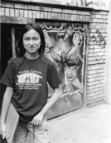Victoria Law's Blog, page 10
December 8, 2011
the other part of abolition (with a video link!)
When I sent the manuscript of Resistance Behind Bars: The Struggles Of Incarcerated Women to the publisher, I knew that, if I didn't have some other big project to keep me occupied, I would drive myself up the wall waiting for edits and responses. Having been warned that publishing takes a long long time, I decided to dust off a dormant writing project.
In 2005, Daniel Burton-Rose approached me about writing an article for an anthology on 1960s and 1970s radical social justice movements. The article would be partly about women imprisoned for self-defense and partly about the women's self-defense groups and organizations that sprung up around that same time (think Outlaw Woman: A Memoir of the War Years 1960-1975 and Cell 16).
I began researching and writing. I realized that I couldn't really tell this story without also including the stories of women imprisoned for killing their batterers. Daniel agreed and so we narrowed the focus to women imprisoned for self-defense (both those who were famous and had huge support movements and those who were not). The notes I had gathered on women's grassroots self-defense got shoved into a corner and collected dust while the article became part of The Hidden 1970s: Histories of Radicalism.
Last year, I finally put those notes to use, turning it into an article on women's grassroots organizing against gender violence for Contemporary Justice Review.
Earlier this year, I did an interview with Angola 3 News. The first part of the interview has been published on Truthout as part of the 16 days of action to End Violence Against Women campaign. You can see the video here:
http://www.youtube.com/watch?v=Qlozk7...
November 30, 2011
and when the book is sent, it's time to break out the chocolate frogs & champagne!
My co-editor China Martens is adding our final Table of Contents to the document and then will have the honor of pushing "SEND." In the meantime, I get to battle rush hour on the NYC subway system to pick up my daughter from afterschool. I will tell her that we finished the book and send it off and she will be unimpressed.
How do I know this? Because two years ago when copies of my first book arrived, hot off the printing presses, I picked my daughter up from afterschool after buying some coconut milk yogurt. We sat outside the school and I showed her my book. "Do you know what this is?" I asked.
Now my daughter had seen the book cover before. She looked at both mock-ups of the cover spread and helped me choose the flower that was on the spine (rather than the face). She nodded, but was more impressed with the yogurt that she was eating than with the actual physical book.
Hmmm, maybe I should rethink my original plan to take her to Economy Candy to buy chocolate frogs (since my daughter is not even 11 and champagne would probably be inappropriate) to celebrate the sending-off of the manuscript.
November 21, 2011
when the (other) book comes together, it's a beautiful thing
And then, when I see movements emerging from these individual acts of organizing and resistance, I get really excited and impassioned all over again.
This weekend, I had the honor of sitting with members of Women on the Rise Telling HerStory to discuss and record their experiences at the recent convening of the Formerly Incarcerated and Convicted People's Movement to include in my second edition. These women's stories are amazing and I am honored that they share them with me.
The next day, I got an e-mail from former political prisoner, prison justice advocate, writer/editor and amazing all-around person Laura Whitehorn letting me know that she had finished writing the introduction to my second edition!
This book is also coming together and, yes, it too is a beautiful thing.
Now back to transcribing that group interview.
October 7, 2011
when the book starts to come together, it's a beautiful thing
This past year, China and I have been working to turn this all into a book. We've gone back and forth, talking not only about the submissions but the larger idea of Don't Leave Your Friends Behind, which is that we shouldn't leave people behind in our quest to transform the world. We've reached out to try to find voices that we don't often hear, such as transsexual and genderqueer parents and caregivers, incarcerated parents or teen moms who make the decision to unschool their kids. It's been a long process and sometimes the overwhelming amount of tedious tasks can be overwhelming.
But today, looking at how these various pieces come together, we both remember why we both agreed to undertake such a time-consuming and often thankless task. This book is going to be a beautiful thing. And even more so, it will be a Beautiful Useful thing in helping to guide some of the discussions that have been popping up about childcare and including children and families in our social justice movements.
Together we can build a better world without leaving anyone behind.



